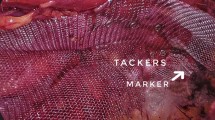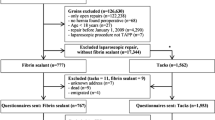Abstract
Purpose
From the current evidence, non-fixation of the mesh (NMF) in laparoscopic total extraperitoneal (TEP) repair appears to be a safe alternative for inguinal hernia patients in the short term. This study aims to demonstrate that NMF is as effective in the long term by following up a large number of patients with a mean follow-up of 6 years. The primary outcomes are chronic pain and recurrence rate.
Methods
A thorough review of medical records was conducted from a prospectively maintained database of 538 patients who underwent a laparoscopic TEP inguinal hernia repair by a single surgeon working in Sydney from the year 2005 to 2010. Patient demographics, perioperative outcomes, and postoperative complications were extracted from this database. All these patients were then interviewed using a modified questionnaire based on Franneby et al. [10].
Result
538 patients had TEP repair between 2005 and 2010. Out of this 11 were excluded as tacks were used for fixation of mesh. Out of the 649 repairs done on 527 patients during this period, 463 hernia repairs in 387 patients could be followed up with a mean follow-up of 6 years and 4 months. The mean age of patients was 63 years. Overall, there were seven (1.5%) recurrences, and the incidence of chronic pain was 1%, however 2.9% patients in total complained of pain.
Conclusion
This is the only study in literature having a long-term follow-up of more than 5 years for the patients having inguinal hernia repair by TEP technique without mesh fixation. It demonstrates that fixation of mesh with tacks or glue is unnecessary for TEP repair of inguinal hernia.
Similar content being viewed by others
References
Teng YJ, Pan SM, Liu YL, Yang KH, Zhang YC, Tian JH, Han JX (2011) A meta-analysis of randomized controlled trials of fixation versus nonfixation of mesh in laparoscopic total extraperitoneal inguinal hernia repair. Surg Endosc 25:2849–2858. doi:10.1007/s00464-011-1668-3
Memon MA, Cooper NJ, Memon B, Memon MI, Abrams KR (2003) Meta-analysis of randomized clinical trials comparing open and laparoscopic inguinal hernia repair. Br J Surg 90:1479–1492. doi:10.1002/bjs.4301
Wong J, Anvari M (2001) Treatment of inguinodynia after laparoscopic herniorrhaphy: a combined laparoscopic and fluoroscopic approach to the removal of helical tackers. Surg Laparosc Endosc Per Tech 11:148–151
Poobalan AS, Bruce J, Smith WCS, King PM, Krukowski ZH, Chambers WA (2003) A review of chronic pain after inguinal herniorrhaphy. Clin J Pain 19:48–54
Boldo E, Armelles A, Perez de Lucia G, Martin F, Aracil JP, Miralles JM, Martinez D, Escrig J (2008) Pain after laparascopic bilateral hernioplasty: early results of a prospective randomized double-blind study comparing fibrin versus staples. Surg Endosc 22:1206–1209. doi:10.1007/s00464-007-9587-z
Olmi S, Scaini A, Erba L, Guaglio M, Croce E (2007) Quantification of pain in laparoscopic transabdominal preperitoneal (TAPP) inguinal hernioplasty identifies marked differences between prosthesis fixation systems. Surgery 142:40–46. doi:10.1016/j.surg.2007.02.013
Lovisetto F, Zonta S, Rota E, Mazzilli M, Bardone M, Bottero L, Faillace G, Longoni M (2007) Use of human fibrin glue (Tissucol) versus staples for mesh fixation in laparoscopic transabdominal preperitoneal hernioplasty: a prospective, randomized study. Ann Surg 245:222–231. doi:10.1097/01.sla.0000245832.59478.c6
Sajid MS, Ladwa N, Kalra L, Hutson K, Sains P, Baig MK (2012) A meta-analysis examining the use of tacker. Int J Surg 10:224–231. doi:10.1016/j.ijsu.2012.03.001
Novik B, Hagedorn S, Mork U-B, Dahlin K, Skullman S, Dalenback J (2006) Fibrin glue for securing the mesh in laparoscopic totally extraperitoneal inguinal hernia repair: a study with a 40-month prospective follow-up period. Surg Endosc 20:462–467. doi:10.1007/s00464-005-0391-3
Fränneby U, Gunnarsson U, Andersson M, Heuman R, Nordin P, Nyrén O, Sandblom G (2008) Validation of an Inguinal Pain Questionnaire for assessment of chronic pain after groin hernia repair. Br J Surg 95:488–493. doi:10.1002/bjs.6014
Tam K-W, Liang H-H, Chai C-Y (2010) Outcomes of staple fixation of mesh versus nonfixation in laparoscopic total extraperitoneal inguinal repair: a meta-analysis of randomized controlled trials. World J Surg 34:3065–3074. doi:10.1007/s00268-010-0760-5
Taylor C, Layani L, Liew V, Ghusn M, Crampton N, White S (2008) Laparoscopic inguinal hernia repair without mesh fixation, early results of a large randomised clinical trial. Surg Endosc 22:757–762. doi:10.1007/s00464-007-9510-7
Staarink M, Veen RN, Hop WC, Weidema WF (2008) A 10-year follow-up study on endoscopic total extraperitoneal repair of primary and recurrent inguinal hernia. Surg Endosc 22:1803–1806. doi:10.1007/s00464-008-9917-9
Messenger DE, Aroori S, Vipond MN (2010) Five-year prospective follow-up of 430 laparoscopic totally extraperitoneal inguinal hernia repairs in 275 patients. Ann R Coll Surg Engl. doi:10.1308/003588410X12628812458455
Eklund AS, Montgomery AK, Rasmussen IC, Sandbue RP, Bergkvist LA, Rudberg CR (2009) Low recurrence rate after laparoscopic (TEP) and open (Lichtenstein) inguinal hernia repair: a randomized, multicenter trial with 5-year follow-up. Ann Surg 249:33–38. doi:10.1097/SLA.0b013e31819255d0
Sajid MS, Ladwa N, Kalra L, McFall M, Baig MK, Sains P (2013) A meta-analysis examining the use of tacker mesh fixation versus glue mesh fixation in laparoscopic inguinal hernia repair. Am J Surg 206:103–111. doi:10.1016/j.amjsurg.2012.09.003
Lau H (2005) Fibrin sealant versus mechanical stapling for mesh fixation during endoscopic extraperitoneal inguinal hernioplasty. Ann Surg 242:670–675. doi:10.1097/01.sla.0000186440.02977.de
Khaleal F, Berney C (2011) The role of fibrin glue in decreasing chronic pain in laparoscopic totally extraperitoneal (TEP) inguinal hernia repair: a single surgeon’s experience. ANZ J Surg 81:154–158. doi:10.1111/j.1445-2197.2010.05438.x
Birk D, Hess S, Garcia-Pardo C (2013) Low recurrence rate and low chronic pain associated with inguinal hernia repair by laparoscopic placement of Parietex ProGrip™ mesh: clinical outcomes of 220 hernias with mean follow-up at 23 months. Hernia 17:313–320. doi:10.1007/s10029-013-1053-3
Ferzli GS, Frezza EE, Pecoraro AM Jr (1999) Prospective randomized study of stapled versus unstapled mesh in a laparoscopic preperitoneal inguinal hernia repair. J Am Coll Surg 188(5):461–465
Khajanchee YS, Urbach DR, Swanstrom LL, Hansen PD (2001) Outcomes of laparoscopic herniorrhaphy without fixation of mesh to the abdominal wall. Surg Endosc 15:1102–1107. doi:10.1007/s004640080088
Messaris E, Nicastri G, Dudrick SJ (2010) Total extraperitoneal laparoscopic inguinal hernia repair without mesh fixation: prospective study with 1-year follow-up results. Arch Surg 145(4):334–338
Pankaj Garg MI (2009) Laparoscopic total extraperitoneal repair in femoral hernia without fixation of the mesh. J Soc Laparoendosc Surg 13:597–600. doi:10.4293/108680809X12589999537995
Bansal VK, Misra MC, Babu D, Victor J, Kumar S, Sagar R, Rajeshwari S, Krishna A, Rewari V (2013) A prospective, randomized comparison of long-term outcomes: chronic groin pain and quality of life following totally extraperitoneal (TEP) and transabdominal preperitoneal (TAPP) laparoscopic inguinal hernia repair. Surg Endosc 27:2373–2382. doi:10.1007/s00464-013-2797-7
Eklund A, Montgomery A, Bergkvist L (2010) Chronic pain 5 years after randomized comparison of laparoscopic and Lichtenstein inguinal hernia repair. Br J Surg 97(4):600–608. doi:10.1002/bjs.6904
Koch CA, Greenlee SM, Larson DR, Harrington JR, Farley DR (2006) Randomized prospective study of totally extraperitoneal inguinal hernia repair: fixation versus no fixation of mesh. J Soc Laparoendosc Surg 10(4):457–460
Phillips EH, Arregui M, Carroll BJ, Corbitt J, Crafton WB, Fallas MJ, Filipi C, Fitzgibbons RJ, Franklin MJ, McKernan B (1995) Incidence of complications following laparoscopic hernioplasty. Surg Endosc 9:16–21
Liem MS, van Duyn EB, van der Graaf Y, van Vroonhoven TJ, Coala Trial Group (2003) Recurrences after conventional anterior and laparoscopic inguinal hernia repair: a randomized comparison. Ann Surg 237(1):136–141
Choy C, Shapiro K, Patel S, Graham A, Ferzli G (2004) Investigating a possible cause of mesh migration during totally extraperitoneal (TEP) repair. Surg Endosc 18:523–525. doi:10.1007/s00464-003-8183-0
Ali SM, Zendejas B, Yadav S, Hernandez-Irizarry RC, Lohse CM, Farley DR (2013) Predictors of chronic groin discomfort after laparoscopic totally extraperitoneal inguinal hernia repair. J Am Coll Surg 217:72–78. doi:10.1016/j.jamcollsurg.2013.03.005 (discussion 78–80)
Author information
Authors and Affiliations
Corresponding author
Ethics declarations
Conflict of interest
Dr SG and Dr PM have no competing interests or financial ties to disclose.
Ethical statement
All procedures performed in studies involving human participants were in accordance with the ethical standards of the institutional and/or national research committee and with the 1964 Helsinki Declaration and its later amendments or comparable ethical standards. For this type of study formal consent is not required.
Statement of human and animal rights
This article does not contain any studies with animals performed by any of the authors.
Informed consent
Informed consent was indeed obtained from all individual participant included in the study.
Rights and permissions
About this article
Cite this article
Golani, S., Middleton, P. Long-term follow-up of laparoscopic total extraperitoneal (TEP) repair in inguinal hernia without mesh fixation. Hernia 21, 37–43 (2017). https://doi.org/10.1007/s10029-016-1558-7
Received:
Accepted:
Published:
Issue Date:
DOI: https://doi.org/10.1007/s10029-016-1558-7




